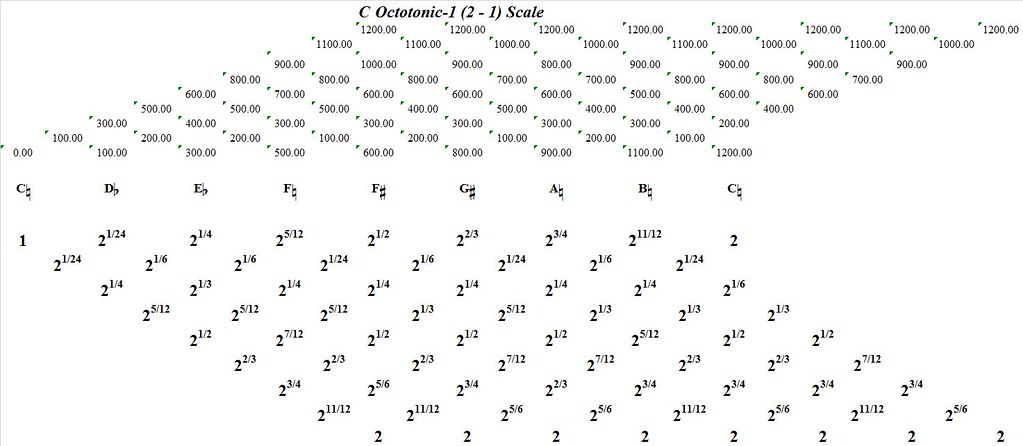
The B Whole-tone (2 - 1) 1% wide Scale. The whole-tone scale altered and stretched.
People who have built up cultural capital and pride themselves on their superior discernment are naturally going to cultivate ever more obscure musical tastes. I’m not sure they enjoy music more than the throngs who sat around listening to Led Zeppelin, but they can certainly feel more individualistic and special.Why does a lack of curiosity pass for virtue with the conservative crowd? Speaking as one who cultivates "obscure" musical tastes, I don't think feeling "individualistic" or "special" has ever been a motivation or even an end result. Led Zeppelin is fine for those who like music. For those who love music their appetite can never be satisfied by just one flavor. It's not about "superior discernment." It's about passion and curiosity.
Technology drives some of the fragmentation. Computers allow musicians to produce a broader range of sounds. Top 40 radio no longer serves as the gateway for the listening public. Music industry executives can use market research to divide consumers into narrower and narrower slices.This vastly overstates the influence and abilities of the dinosaur class known as "music industry executive." Computers have had a democratizing effect on music creation and consumption. The executive class has shrinking influence over consumer behavior and can niche-market themselves into oblivion for all anyone cares. This is a vast improvement over the narrow gateways of corporate record labels and tightly controlled Top 40 radio. Again, Top 40 is fine for people who like music. For those who love music it's merely a single strain within a vast ecosystem. Fragmentation is a sign of a healthy, creative environment with plenty of species diversity. Limiting one's listening to Top 40 is a little like subsisting on a diet of marshmallows.
...if the Rolling Stones came along now, they wouldn’t be able to get mass airtime because there is no broadcast vehicle for all-purpose rock.If the need arises for another Rolling Stones then it will happen. Until that time they will not be missed. Moving away from the questionable acoustics of big arena shows can only be a good thing. Past cultural phenomena such as the Beatles and the Rolling Stones were a product of a less cynical time and less tech-savvy consumer base.
Van Zandt has a way to counter all this, at least where music is concerned. He’s drawn up a high school music curriculum that tells American history through music. It would introduce students to Muddy Waters, the Mississippi Sheiks, Bob Dylan and the Allman Brothers. He’s trying to use music to motivate and engage students, but most of all, he is trying to establish a canon, a common tradition that reminds students that they are inheritors of a long conversation.A music curriculum that exposes young ears to music traditions is a positive step. Though this list is suspiciously narrow in its scope. My sense of American music history includes Charles Ives, Henry Cowell, Duke Ellington, Pauline Oliveros, John Cage, Albert Ayler, Terry Riley, Carl Ruggles, Edgard Varese, Anthony Braxton, John Coltrane, Sun Ra, Art Tatum, Kenny Dorham, Billy Strayhorn, Irving Berlin, Robert Johnson, Ruth Crawford-Seeger, Don Cherry, Ornette Coleman, Bill Frisell, Carl Stalling, Raymond Scott, Carla Bley, Louis Armstrong and many others with equal claim to that "common tradition" over the past century and a half. The true goal of such a music education should be to stimulate and encourage students to seek out and discover the experience of hearing such a rich musical heritage. I'm concerned that the curriculum Brooks alludes to simply hands down a narrow subset without encouraging deeper thought and exploration. I'm suspicious of any canon that doesn't cultivate curiosity - the lack of which is not a virtue.
 Michael Moore Trio: Chicoutimi. 1993. Ramboy: 06.
Michael Moore Trio: Chicoutimi. 1993. Ramboy: 06. Arnold Schoenberg: Moses und Aron. Recorded in 1996. Deutsche Grammophon: 449 174-2.
Arnold Schoenberg: Moses und Aron. Recorded in 1996. Deutsche Grammophon: 449 174-2. Skeleton Crew: Learn To Talk/The Country of Blinds. 1984, 1986 - re-released in 2005. Fred Records/Anthill Music: ReR/FRO 8/9.
Skeleton Crew: Learn To Talk/The Country of Blinds. 1984, 1986 - re-released in 2005. Fred Records/Anthill Music: ReR/FRO 8/9. Saxophone Summit @ The Red Room, Baltimore, MD
Saxophone Summit @ The Red Room, Baltimore, MD Kenny Dorham: Trompeta Toccata. 1964. Re-released in 2006. Blue Note Records: 0946 3 62635 2 6.
Kenny Dorham: Trompeta Toccata. 1964. Re-released in 2006. Blue Note Records: 0946 3 62635 2 6. Marianne Trudel Quintet: Sands of Time. 2007. TRUD 2007-1.
Marianne Trudel Quintet: Sands of Time. 2007. TRUD 2007-1. Herbie Hancock: Empyrean Isles. 1964. Re-released in 1999. Blue Note Records: 7243 4 98796 2 1.
Herbie Hancock: Empyrean Isles. 1964. Re-released in 1999. Blue Note Records: 7243 4 98796 2 1. Muzikas: The Bartok Album. 1999. Rykodisc: HNCD 1439.
Muzikas: The Bartok Album. 1999. Rykodisc: HNCD 1439. Chicago Tentet: American Landscapes 2. 2007. Okka Disk: OD12068.
Chicago Tentet: American Landscapes 2. 2007. Okka Disk: OD12068. Matana Roberts: Matana. 2007. Individually painted CD-R available from the composer.
Matana Roberts: Matana. 2007. Individually painted CD-R available from the composer. Sylvie Courvoisier: Signs and Epigrams. 2007. Tzadik: TZ 8033.
Sylvie Courvoisier: Signs and Epigrams. 2007. Tzadik: TZ 8033. Billy Bang: Vietnam: The Aftermath. 2001. Justin Time Records: Just 165-2.
Billy Bang: Vietnam: The Aftermath. 2001. Justin Time Records: Just 165-2. Laurie Anderson: Life On A String. 2001. Nonesuch: 79539-2.
Laurie Anderson: Life On A String. 2001. Nonesuch: 79539-2.
 Ludwig van Beethoven: The Symphonies [disc 3]. Recorded in 1994. The International Music Company: 205298-305.
Ludwig van Beethoven: The Symphonies [disc 3]. Recorded in 1994. The International Music Company: 205298-305. Ludwig van Beethoven: The Complete Quartets, volume II. Recorded in 1989. Delos: CD 3032.
Ludwig van Beethoven: The Complete Quartets, volume II. Recorded in 1989. Delos: CD 3032. Albert Ayler: Holy Ghost box set [disc 1]. 2004. Revenant Records: 213.
Albert Ayler: Holy Ghost box set [disc 1]. 2004. Revenant Records: 213. Olivier Messiaen: Turangalila Symphony. Recorded in 1967, re-released in 2004. RCA Records: 82876-59418-2.
Olivier Messiaen: Turangalila Symphony. Recorded in 1967, re-released in 2004. RCA Records: 82876-59418-2. Jenny Scheinman: 12 Songs. 2005. Cryptogramophone: CG125.
Jenny Scheinman: 12 Songs. 2005. Cryptogramophone: CG125. Anthony Braxton: 9 Compositions (Iridium) 2006 [disc 4]. 2006: Firehouse 12 Records: FH12-04-03-001.
Anthony Braxton: 9 Compositions (Iridium) 2006 [disc 4]. 2006: Firehouse 12 Records: FH12-04-03-001. Sleeping People/The Zs/Yip Yip/The Locust
Sleeping People/The Zs/Yip Yip/The Locust The Zs perform in a tight, box configuration facing each other over music stands and reams of notated scores. This constant visual communication allows them to execute rapid fire unison lines with blisteringly rehearsed precision. It also places the saxophonist with his back to the audience and conveys a calculated indifference toward stage orientation. The uncompromising music that pours out - sometimes in heavy bursts punctuated by deliberate silences - is at times passionately unpredictable and repetitive. It is also stark and profoundly appealing music.
The Zs perform in a tight, box configuration facing each other over music stands and reams of notated scores. This constant visual communication allows them to execute rapid fire unison lines with blisteringly rehearsed precision. It also places the saxophonist with his back to the audience and conveys a calculated indifference toward stage orientation. The uncompromising music that pours out - sometimes in heavy bursts punctuated by deliberate silences - is at times passionately unpredictable and repetitive. It is also stark and profoundly appealing music. I have to give props to Yip Yip for their props. The black and white checkered pattern on their custom cases, backdrop and outfits was visually amusing. The Orlando-based duo of vintage, analog synthesizer players enhance their sound with a customized contraption of cymbals, alto saxophone and drum machine. And every time I expected their sound to wear out its welcome they managed to rock a little harder. The drifting intonation of the old school oscillators and their odd transitions were incredibly endearing.
I have to give props to Yip Yip for their props. The black and white checkered pattern on their custom cases, backdrop and outfits was visually amusing. The Orlando-based duo of vintage, analog synthesizer players enhance their sound with a customized contraption of cymbals, alto saxophone and drum machine. And every time I expected their sound to wear out its welcome they managed to rock a little harder. The drifting intonation of the old school oscillators and their odd transitions were incredibly endearing. The cut of the masks around the mouth enhanced the effect of insect-like mandibles as the keyboard player and guitarist issued their scream-heavy vocals. The Locust pour on the kind of hardcore sound one expects when waiting in line at the Ottobar as the mosh pit of slam dancers and stage diving finally materialized around the pounding aggressiveness of their music. It was amusing to hear such punk vocals issuing forth from the Moog synthesizer player. And they certainly had the transfixed attention of the local celebrity attending the show. About half way through their set their material began to wear thin for me and I had to flee the constant barrage of high decibel angst.
The cut of the masks around the mouth enhanced the effect of insect-like mandibles as the keyboard player and guitarist issued their scream-heavy vocals. The Locust pour on the kind of hardcore sound one expects when waiting in line at the Ottobar as the mosh pit of slam dancers and stage diving finally materialized around the pounding aggressiveness of their music. It was amusing to hear such punk vocals issuing forth from the Moog synthesizer player. And they certainly had the transfixed attention of the local celebrity attending the show. About half way through their set their material began to wear thin for me and I had to flee the constant barrage of high decibel angst.
 Skerik's Syncopated Taint Septet: Skerik's Syncopated Taint Septet. 2003. Ropeadope Music Entertainment: 0-7567-93183-2-9.
Skerik's Syncopated Taint Septet: Skerik's Syncopated Taint Septet. 2003. Ropeadope Music Entertainment: 0-7567-93183-2-9. Steve Lacy Quintet: Esteem. 1975. Released in 2004. Atavistic: ALP260CD.
Steve Lacy Quintet: Esteem. 1975. Released in 2004. Atavistic: ALP260CD. Radiohead: OK Computer. 1997. EMI Records: 7243 8 55229 2 5.
Radiohead: OK Computer. 1997. EMI Records: 7243 8 55229 2 5. Chris McGregor's Brotherhood of Breath: Bremen to Bridgwater. 1971, 1975 - re-issued in 2004. Cuneiform Records: Rune 182/183.
Chris McGregor's Brotherhood of Breath: Bremen to Bridgwater. 1971, 1975 - re-issued in 2004. Cuneiform Records: Rune 182/183. Forbes Graham: Another Return. 2007. Self produced CD-R available from the composer.
Forbes Graham: Another Return. 2007. Self produced CD-R available from the composer. Jason Kao Hwang: Edge. 2006. Asian Improv Records: AIR0067.
Jason Kao Hwang: Edge. 2006. Asian Improv Records: AIR0067. The Autumn Concert of After Now: Nothing You've Heard Before
The Autumn Concert of After Now: Nothing You've Heard Before Peter Brötzmann/Michael Zerang: Live in Beirut. 2005. Al Maslakh Recordings: 03.
Peter Brötzmann/Michael Zerang: Live in Beirut. 2005. Al Maslakh Recordings: 03. Peter Apfelbaum & The Hieroglyphics Ensemble: Jodoji Brightness. 1992. Antilles/Polygram Records: 314-512 320-2.
Peter Apfelbaum & The Hieroglyphics Ensemble: Jodoji Brightness. 1992. Antilles/Polygram Records: 314-512 320-2. Peter Brötzmann Octet: The Complete Machine Gun Sessions. 1968. Re-mastered and re-issued in 2007 with additional materials. Atavistic: ALP262CD.
Peter Brötzmann Octet: The Complete Machine Gun Sessions. 1968. Re-mastered and re-issued in 2007 with additional materials. Atavistic: ALP262CD.
 Ludwig van Beethoven: The Symphonies [disc 1]. Recorded in 1994. The International Music Company: 205297-305.
Ludwig van Beethoven: The Symphonies [disc 1]. Recorded in 1994. The International Music Company: 205297-305. Donkey Monkey: Ouature. 2007. Umlaut Records: UMCD 0005.
Donkey Monkey: Ouature. 2007. Umlaut Records: UMCD 0005. Chicago Tentet: American Landscapes 1. 2007. Okkadisk: OD12067.
Chicago Tentet: American Landscapes 1. 2007. Okkadisk: OD12067.